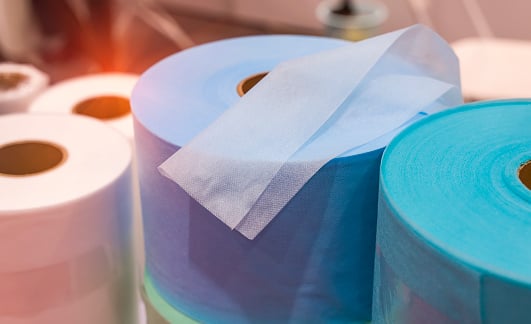Because non-woven fabric resembles cloth in appearance and has some cloth-like characteristics, it is made of aligned or random fibers. Moisture-proof, breathable, flexible, light weight, non-combustion-supporting, easy decomposition, non-toxic and non-irritating, colorful, affordable, recyclable, and reuseable are just a few of the qualities of non-woven materials. For instance, one-step continuous production using PP non-woven fabric granules as the raw material, followed by high temperature melting, spinneret, paving, and hot rolling. The manufacturer of nonwoven fabrics Synwin then introduces nonwoven products.
Introduction of non woven products
Non-woven products are a new generation of environmental protection materials, with features such as moisture-proofing, breathability, flexibility, light weight, non-combustion-supporting, easy decomposition, non-toxic and non-irritating, colorful, low price, recycling, and more. Non-woven fabric is also known as non-woven fabric and is made of directional or random fiber. For instance, one-step continuous production using polypropylene (PP) granules as the raw material, followed by high temperature melting, spinneret, paving, and hot rolling. Therefore, non-woven fabric is a very eco-friendly material. Its environmental performance is superior to that of plastic items, and it degrades naturally much faster than plastic bags do.
characteristics of non-woven products
Non-woven fabrics don't need to be woven, therefore all that is needed for directed or random bracing is a short textile filament to form the fiber net structure, which is subsequently reinforced using mechanical, thermal bonding, or chemical techniques. Since the fibers in non-woven materials are physically linked rather of being woven or braided together, there is no thread to be pulled out when you remove the gauges from your clothing. Non-woven products have overcome the traditional textile principle and have attributes like a quick manufacturing process, high output, low cost, widespread use, and a variety of raw material sources.
Structure of the nonwoven product's component
Non-woven materials are vibrant, energetic, and colorful. They are also extensively utilized, lovely, and generous. They come in a variety of designs and styles, are lightweight, and are known internationally as eco-friendly products that preserve the ecology of the planet. suitable for a variety of industries including agricultural film, footwear, leather, mattresses, lash, décor, the chemical industry, printing, automotive, building materials, furniture, and even today's trendy gift bags, boutique bags, advertising bags, and hotel disposable tablecloths. Eco-friendly non-woven materials are popular and affordable. It is also known as a pearl canvas because of how it appears to be a pearl. Although it is cloth without textile, nonwoven fabrics are created of chemical and plant fibers in the conditions of water or air as a suspension medium in wet or dry paper manufacturing machines. The non-woven product material has a maximum life of 90 days if left outside to decompose naturally. If kept indoors to decompose, it takes 8 years and involves burning non-toxic, flavorless, and residue-free materials, which prevents environmental pollution.
Utilization of non-woven products
(1) Clothing for health and medicine, such as surgical gowns, safety gear, antiseptic wraps, masks, diapers, and women's sanitary products;
(2) textiles used for family adornment, such as tablecloths, bed linens, and blankets;
(3) with the use of fabric for installation, such as lining, adhesive lining, flocculant, shaping cotton, various synthetic leather bottom cloth, etc.;
(4) Industrial fabric, such as coated cloth, geotextiles, cement packing bags, filter materials, and insulating materials;
(5) Agricultural Cloth, such as Insulation Curtain, Irrigation Cloth, and Crop Protection Cloth;
(6) Other: tea bags, smoke filters, oil-absorbing felt, space cotton, heat- and sound-insulating materials, etc.
Putting non-woven items into categories
1. A layer or several fiber networks are sprayed with high pressure, fine water during the spinning process to create a spunlaced non-woven fabric, which allows the fiber network to be strengthened and have a specified strength.
2. The fiber network in the fiber or powder hot melt bonding reinforcement material, fiber network after heating, melting, and chilling reinforcement into cloth, is referred to as thermal non-woven fabric.
3. Pulp air flow into net nonwoven fabric: Also known as dust-free paper and dry papermaking non-woven fabric, this term refers to pulp air flow into net nonwoven fabric. In order to create wood pulp fiberboard open loosely into a single fiber state and then to make fiber agglutination in the net curtain and fiber net reinforcing into fabric, it is necessary to employ air flow into the net technology.
4. Wet non-woven fabric: Wet non-woven fabric is made of fiber raw materials that are allowed to expand freely into a single fiber and are then mixed together with other raw materials to create fiber suspension pulp. This suspension pulp is then transported to a net mechanism where the fiber is placed in a wet state before being strengthened into cloth.
5. Spunbonded non-woven fabric is made from a continuous thread of polymer that has been stretched, extruded, and shaped into a net. The net then undergoes mechanical reinforcing, thermal bonding, chemical bonding, or spinning to make a non-woven fabric.
6. Nonwoven fabric that has been melt-blown Polymer feeding, melt extrusion, fiber creation, fiber chilling, net reinforcing, and fabric formation are the steps in the production of melt-blown nonwoven fabrics.
7. Non-woven fabric used for needlework is a type of dry non-woven fabric. Non-woven fabrics are needled in order to reinforce the fluff-filled fiber net and create cloth.
8. Non-woven fabric that has been sewn is a type of dry non-woven fabric. In the stitched knitting technique, the fiber net, yarn layer, non-textile materials (such as plastic sheet, thin metal foil, etc.), or their combination, are reinforced using the warp knitting coil structure to create non-woven fabric.
9. Utilized mostly in the creation of medical and health products, hydrophilic non-woven cloth has a better feel and won't irritate the skin. Sanitary gaskets employ a hydrophilic nonwoven material similar to sanitary napkins.
Get in touch with GREENCARE right away if you need assistance with your project needs.

